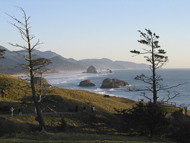Oregon Public Health Reports No Health Risk From Trace Radiation From Japan

The Oregon Public Health Division and the Environmental Protection Agency continue to track levels of radiation linked to the Japan tsunami and nuclear reactor incident.
Beginning in April 2012, in light of the potential landfall of Japan Tsunami marine debris along the Oregon coast, OPH and RPS began enhanced sampling activity of surf water, sand from the high tide line and drinking water from three locations along the Oregon coast.
In March 2013, RPS performed a scientific review that included 12 months worth of data obtained from the coastal sample analyses. The results of the review show that it is highly unlikely that Japan tsunami marine debris presents a radiation public health risk.
Based on the review of the data collected to date, effective April 2013, RPS has changed it sampling protocol to quarterly. RPS will continue to work with the Beach Rangers and the Department of Parks and Recreation to collect samples and will continue to post the results on our website. If RPS does identify an increase of activity from any of the collected samples, it will increase the sampling frequency to ensure the safety of our beaches and the health of the citizens of the state of Oregon.
On May 1, 2017, RPS performed its second review of the scientific data collected since the inception of the beach monitoring program in April, 2012. Based on the results collected to date, there is no scientific evidence that Japan Tsunami marine debris presents a radiation health concern. As such, RPS is changing the sampling protocol from quarterly to semi-annually. Working in cooperation with the Department of Parks and Recreation's Beach Rangers program, RPS will collect samples of ocean water, sand from the high tide line, and drinking water in May and November. The results of the sample analysis will be published on the RPS web page as they become available. In the event that RPS does detect an increase of activity from any of the collected samples, it will revert back to a more frequent sampling schedule.
Sand Data - Gamma Spectroscopy Analysis
The following data comes from various sand samples collected from designated spots along the northern, central and southern Oregon coast. All of the samples are analyzed for cesium-137 and iodine-131 content.
Coastal sand samples are collected and analyzed quarterly. Data is updated on the website quarterly.
Data:
| Sample Date |
Sample Location |
Cesium - 137
Activity (pCi/L) |
Iodine - 131
Activity (pCi/L) |
| 02/11/2016 |
Heceta Beach |
*<MDA |
*<MDA |
| 2/12/2016 |
Harris Beach |
*<MDA |
*<MDA |
| 02/18/2016 |
Peter Iredale |
*<MDA |
*<MDA |
| 05/09/2016 |
Harris Beach |
*<MDA |
*<MDA |
| 05/12/2016 |
Heceta Beach |
*<MDA |
*<MDA |
| 05/18/2016 |
Fort Stevens |
*<MDA |
*<MDA |
| 08/09/2016 |
Harris Beach |
*<MDA |
*<MDA
|
| 08/12/2016 |
Heceta Beach |
*<MDA |
*<MDA |
| 08/13/2016 |
Fort Stevens |
*<MDA |
*<MDA |
| 11/10/2016 |
Harris Beach |
*<MDA |
*<MDA |
| 11/10/2016 |
Heceta Beach |
*<MDA |
*<MDA |
| 11/13/2016 |
Fort Stevens |
*<MDA |
*<MDA |
| 02/14/2017 |
Heceta Beach |
*<MDA |
*<MDA |
| 02/15/2017 |
Fort Stevens |
*<MDA |
*<MDA |
| 02/15/2017 |
Harris Beach |
*<MDA |
*<MDA
|
05/14/2017
| Harris Beach
| *<MDA
| *<MDA
|
05/15/2017
| Heceta Beach
| *<MDA
| *<MDA
|
05/18/2017
| Peter Iredale
| *<MDA
| *<MDA
|
11/14/2017
| Harris Beach
| *<MDA
| *<MDA
|
11/15/2017
| Heceta Beach
| *<MDA
| *<MDA
|
05/01/2018
| Harris Beach
| *<MDA
| *<MDA
|
05/29/2018
| Ft. Stevens
| *<MDA
| *<MDA
|
11/12/2018
| Harris Beach
| *<MDA
| *<MDA
|
11/18/2018
| Peter Iredale
| *<MDA
| *<MDA
|
05/13/2019
| Harris Beach
| *<MDA
| *<MDA
|
05/15/2019
| Peter Iredale
| *<MDA
| *<MDA
|
05/16/2019
| Heceta Beach
| *<MDA
| *<MDA
|
*Minimum Detectable Activity (MDA): The MDA is defined as the smallest quantity of radioactivity that can be distinguished from background radiation under specified conditions.
Units: Picocurie (pCi): A unit of measurement that tells you the rate at which a sample of radioactive material decays.
1 pCi=0.037 Becquerel (Bq) = 2.22 disintegrations/minute.